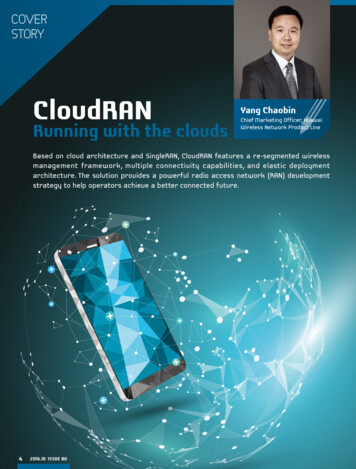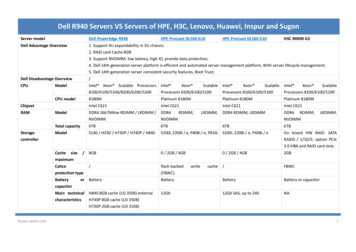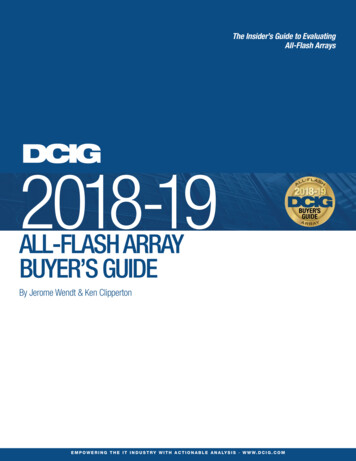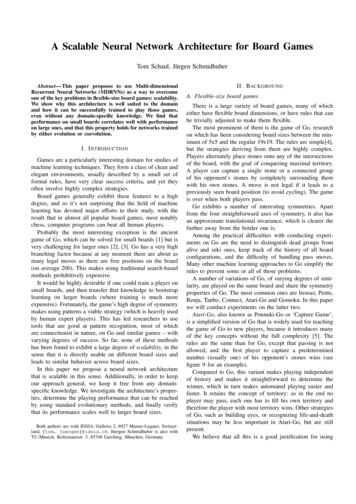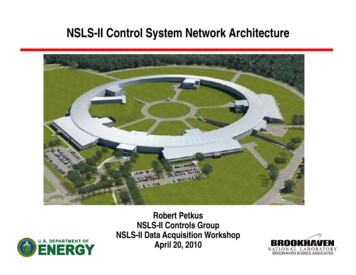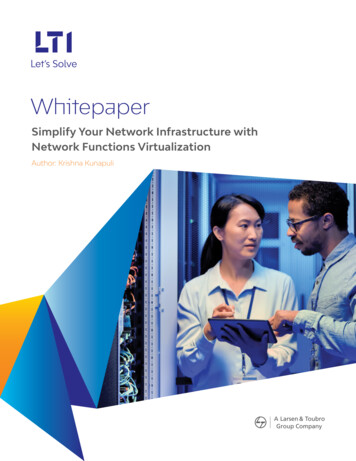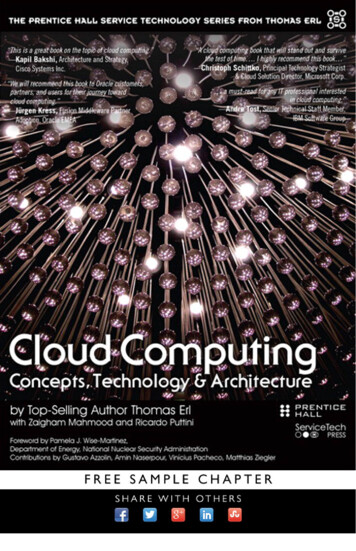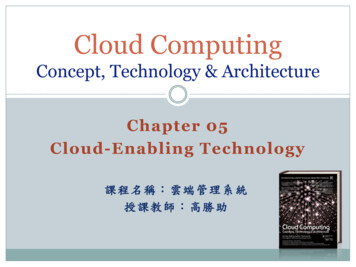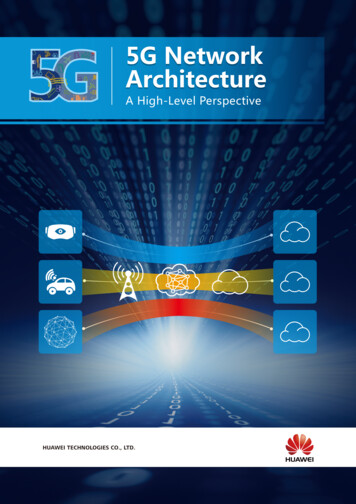
Transcription
5G Network Architecture-A High Level View5G NetworkArchitectureA High-Level Perspective1
5GNetwork Architecture-A High Level View2
5G Network Architecture-A High Level ViewContentsA Cloud-Native 5G Architecture is Keyto Enabling Diversified Service Requirements045G Will Enrich the Telecommunication Ecosystem051.1 The Driving Force Behind Network Architecture Transformation1.2 The Service-Driven 5G ArchitectureEnd-to-End Network Slicing for MultipleIndustries Based on One Physical Infrastructure08Reconstructing the RAN with Cloud093.1 Multi-Connectivity Is Key to High Speed and Reliability3.2 MCECloud-Native New Core Architecture4.1 Control and User Plane Separation Simplifies the Core Network4.2 Flexible Network Components Satisfy Various Service Requirements4.3 Unified Database Management13Self-Service Agile Operation17Conclusion:19Cloud-Native Architecture is the Foundation of 5G Innovation3
5GNetwork Architecture-A High Level ViewA Cloud-Native 5G Architectureis Key to Enabling DiversifiedService RequirementsThrough persistent effort and determination Telecom operators are implementing adigital transformation to create a better digital world. To provide enterprises and individualswith a real time, on demand, all online, DIY, social (ROADS) experience requires an endto-end (E2E) coordinated architecture featuring agile, automatic, and intelligent operationduring each phase. The comprehensive cloud adaptation of networks, operation systems,and services is a prerequisite for this much anticipated digital transformation.The "All Cloud" strategy is an illuminated exploration into hardware resource pools,distributed software architecture, and automatic deployment.Operators transform networks using a network architecturebased on data center (DC) in which all functions and serviceapplications are running on the cloud DC, referred to as a CloudNative architecture.In the 5G era, a single network infrastructure can meetdiversified service requirements. A Cloud-Native E2E networkarchitecture has the following attributes:ᵒᵒ Provides logically independent network slicing on asingle network infrastructure to meet diversified servicerequirements and provides DC-based cloud architecture tosupport various application scenarios.ᵒᵒ Uses CloudRAN to reconstruct radio access networks (RAN)to provide massive connections of multiple standards andimplement on-demand deployment of RAN functionsrequired by 5G.ᵒᵒ Simplifies core network architecture to implement ondemand configuration of network functions throughcontrol and user plane separation, component-basedfunctions, and unified database management.ᵒᵒ Implements automatic network slicing service generation,maintenance, and termination for various services toreduce operating expenses through agile network O&M.4
5G Network Architecture-A High Level View5G Will Enrich theTelecommunication EcosystemIn the new exciting era of 5G, new communication requirements pose challenges onexisting networks in terms of technologies and business models. The next-generation mobilenetwork must meet diversified demands. The International Telecommunication Union (ITU)has classified 5G mobile network services into three categories: Enhanced Mobile Broadband(eMBB), Ultra-reliable and Low-latency Communications (uRLLC), and Massive Machine TypeCommunications (mMTC). eMBB aims to meet the people's demand for an increasinglydigital lifestyle, and focuses on services that have high requirements for bandwidth, suchas high definition (HD) videos, virtual reality (VR), and augmented reality (AR). uRLLC aimsto meet expectations for the demanding digital industry and focuses on latency-sensitiveservices, such as assisted and automated driving, and remote management. mMTC aims tomeet demands for a further developed digital society and focuses on services that includehigh requirements for connection density, such as smart city and smart agriculture.The expansion of service scope for mobile networks enriches the telecom networkecosystem. A number of traditional industries, such as automotive, healthcare, energy, andmunicipal systems participate in the construction of this ecosystem. 5G is the beginningof the promotion of digitalization from personal entertainment to society interconnection.Digitalization creates tremendous opportunities for the mobile communication industry butposes strict challenges towards mobile communication technologies.10GbpsEnhanced MobileBroadbandeMBB3D Video, UHD ScreenWork and play in the cloudSmart Home/BuildingAugmented realityIndustry automationSmart CityMission criticalFuture IMTapplicationsSelf driving carmMTCMassive Machine TypeCommunications1million/km 2ITU-R WP5DuRLLCUltra-reliable and Low-latencyCommunications1ms5
5GNetwork Architecture-A High Level ViewA. The Driving Force Behind NetworkArchitecture TransformationThe existing mobile network architecturewas designed to meet requirements for voiceand conventional MBB services. However,this previous organization has proven to beinsufficiently flexible to support diversified5G services due to multiple 3GPP versionupgrades, a large number of NEs, complexinterfaces. The driving force behind thenetwork architecture transformation includesthe following aspects:·Complex networks incorporating multiple services, standards, andsite types5G networks must be able to provide diversified services of different KPIs, support co-existent accesses of multiple standards(5G, LTE, and Wi-Fi), and coordinate different site types (macro, micro, and pico base stations). The design challenge to create anetwork architecture capable of supporting such flexibility whilst meeting differentiated access demands is a brave endeavor tosatisfy.·Coordination of multi-connectivity technologies5G is expected to co-exist with LTE and Wi-Fi for an extended period of time incorporating multi-connectivity technologies andthe new 5G air interface. Multi-connectivity technologies must be coordinated based on traffic and mobility requirements ofuser equipment to provide sufficient transmission throughput and mobile continuity.·On-demand deployment of service anchors5G network architecture will be designed based on access sites and three-layer DCs. According to different service requirements,fiber/optic cable availability and network resource allocations, RAN real time and non-real time resources can be deployed onthe site or on the access cloud side. This further requires that the service gateway location may also be deployed on the accesscloud or on the core network side.·Flexible orchestration of network functionsService requirements vary with different network functions. eMBB requires a large throughput for scheduling. uRLLC requiresultra-low latency and high reliability. Networks must flexibly orchestrate network capabilities considering service characteristics,which significantly simplify network functions and increase network efficiency.·Shorter period of service deploymentVarious services have expanded the mobile network ecosystem and increased network deployment complexity. Rapidlydeploying new services requires an improved set of lifecycle management processes involving network design, servicedeployment, and O&M.6
5G Network Architecture-A High Level ViewB. The Service-Driven 5G ArchitectureThe service-driven 5G network architecture aims to flexibly and efficiently meetdiversified mobile service requirements. With software-defined networking (SDN) andNetwork Functions Virtualization (NFV) supporting the underlying physical infrastructure,5G comprehensively cloudifies access, transport, and core networks. Cloud adoption allowsfor better support for diversified 5G services, and enables the key technologies of E2Enetwork slicing, on-demand deployment of service anchors, and component-based networkfunctions.eMBBE2E Management PlaneEnable PlaneuRLLCSlicing ManagementNetwork Service EnablermMTCResource ManagementComplex Event ProcessAnalyticsUnified DatabaseLTE5GRAN Real TimeMulti -RATAccess Mgmt.WIFIComposable Control Function (CP)Service User DataMMSMCtrlRAN Non-Real TimecRRCcRRMGW - UACApplicationPolicy DataSDNControllerService Ctrl Plane ServiceService ComponentSecurity Mgmt. Policy Mgmt.Component eGTPMobile Cloud Engine (MCE)CloudRANProgrammable Data Forwarding (UP)GW-UGW-UGW-UGW-UService Oriented Core (SOC)CloudRAN consists of sites and mobile cloud engines. This facility coordinates multipleservices, operating on different standards, in various site types for RAN real time resourcesthat require a number of computing resources. Multi-connectivity is introduced to allowon-demand network deployment for RAN non-real time resources. Networks implementpolicy control using dynamic policy, semi-static user, and static network data stored inthe unified database on the core network side. Component-based control planes andprogrammable user planes allow for network function orchestration to ensure that networkscan select corresponding control-plane or user-plane functions according to different servicerequirements. The transport network consists of SDN controllers and underlying forwardingnodes. SDN controllers generate a series of specific data forwarding paths based on networktopology and service requirements. The enabling plane abstracts and analyzes networkcapabilities to implement network optimization or open network capabilities in the formof API. The top layer of the network architecture implements E2E automatic slicing andnetwork resource management.7
5GNetwork Architecture-A High Level ViewEnd-to-End Network Slicing forMultiple Industries Based on OnePhysical InfrastructureE2E network slicing is a foundation to support diversified 5G services and is key to 5Gnetwork architecture evolution. Based on NFV and SDN, physical infrastructure of the futurenetwork architecture consists of sites and three-layer DCs. Sites support multiple modes (suchas 5G, LTE, and Wi-Fi) in the form of macro, micro, and pico base stations to implement theRAN real time function. These functions have high requirements for computing capabilityand real time performance and require the inclusion of specific dedicated hardware. Threelayer cloud DC consists of computing and storage resources. The bottom layer is the centraloffice DC, which is closest in relative proximity to the base station side. The second layeris the local DC, and the upper layer is the regional DC, with each layer of arranged DCsconnected through transport networks.According to diversified service requirements, networks generate correspondingnetwork topologies and a series of network function sets (network slices) for eachcorresponding service type using NFV on a unified physical infrastructure. Each network sliceis derived from a unified physical network infrastructure, which greatly reduces subsequentoperators' network construction costs. Network slices feature a logical arrangement and areseparated as individual structures, which allows for heavily customizable service functionsand independent O&M.LTERAN-RTRAN-NRTCacheAC5GeMBB SlicingWIFILTEuRLLC ERAN-RT5GmMTC SlicingRAN-NRTWIFIRANCentral Office DCLocal DCSwitchPhysical Infrastructure8IOT ServerCPUPMCERegional DCSwitch
5G Network Architecture-A High Level ViewAs illustrated in the preceding figure, eMBB,uRLLC, and mMTC are independently supportedon a single physical infrastructure. eMBBslicing has high requirements for bandwidth todeploy cache in the mobile cloud engine of alocal DC, which provides high-speed serviceslocated in close proximity to users, reducingbandwidth requirements of backbone networks.uRLLC slicing has strict latency requirements inapplication scenarios of self-driving, assistantdriving, and remote management. RAN real Timeand non-Real Time processing function unitsmust be deployed on the site side providinga beneficial location preferably based in close proximity to users. V2X Server and servicegateways must be deployed in the mobile cloud engine of the central office DC, with onlycontrol-plane functions deployed in the local and regional DCs. mMTC slicing involves asmall amount of network data interaction and a low frequency of signaling interaction inmost MTC scenarios. This consequently allows the mobile cloud engine to be deployed inthe local DC, and other additional functions and application servers can be deployed in theregional DC, which releases central office resources and reduces operating expenses.Reconstructing the RAN with CloudDuring the course of an evolution towards RAN2020, CloudRAN architecture is usedon the RAN side to implement RAN Real Time functions, on-demand deployment of nonreal time resources, component-based functions, flexible coordination, and RAN slicing. WithMobile Cloud Engine (MCE), CloudRAN can implement flexible orchestration for RAN Realtime and non-real Time functions based on different service requirements and transmissionresource configuration to perform cloudification of the RAN.9
5GNetwork Architecture-A High Level ViewThe RAN real time functions include access network scheduling, link adaptation, powercontrol, interference coordination, retransmission, modulation, and coding. These functionsrequire high real-time performance and computing load. The deployment of sites mustinclude dedicated hardware with high accelerator processing specifications and performance,whilst located in close proximity to services. The RAN non-real time functions include intercell handover, cell selection and reselection, user-plane encryption, and multiple connectionconvergence. These functions require minimal real-time performance, latency requirementsto dozens of milliseconds and are suitable for centralized deployment. A universal processorcan be deployed in a MCE or site according to vast service requirements.MCE can implement complex management while coordinating multiple processingcapabilities based on regional time, frequency bands, and space. This upgraded
The design challenge to create a network architecture capable of supporting such flexibility whilst meeting differentiated access demands is a brave endeavor to satisfy. ·Coordination of multi-connectivity technologies 5G is expected to co-exist with LTE and Wi-Fi for an extended period of time incorporating multi-connectivity technologies and the new 5G air interface. Multi-connectivity .

